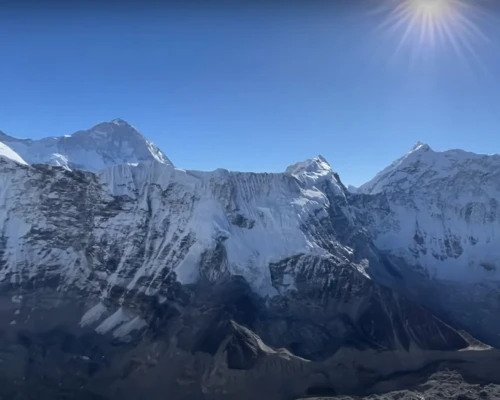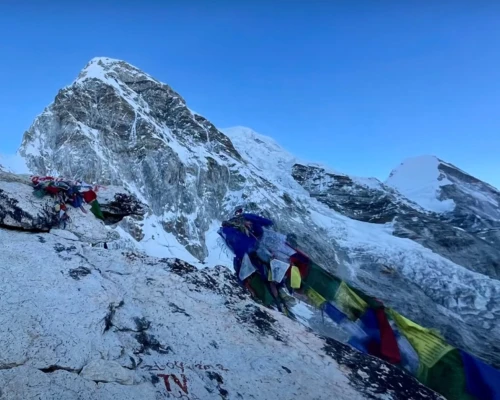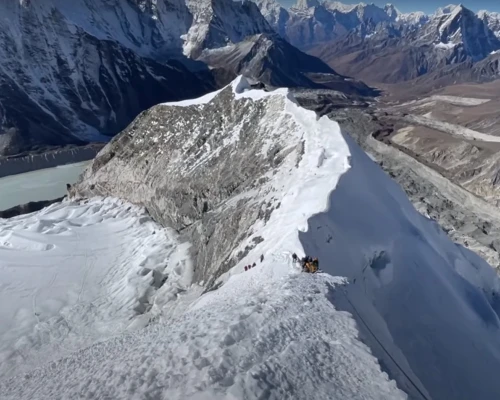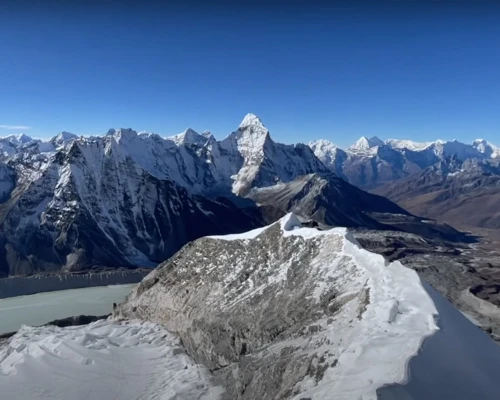Best Time for Island Peak Climbing
The weather and climbing conditions play a crucial role in determining the best time for Island Peak climbing. The preferred seasons are spring (April-May) and autumn (October-November).
During these periods, the weather is stable, with clear blue skies and mild temperatures. Climbing in the offseason, like winter or monsoon, is not recommended due to harsh weather conditions and increased risks.
Island Peak Climbing Difficulties Level
Climbing Island Peak can be physically draining for some new in experienced trekkers, but it is not that difficult to climb. Island Peak Climbing is one of the Moderate and Technical level Peak Climbing in Nepal. If you are planning to do Peak climbing in Nepa. it is the best route for you. It is the ideal mountain for novice climbers to scale before they progress at something big. It is also the perfect Himalayan peak for climbers trying to summit a Himalayan peak for the first time. Mountaineers aims to climb Mount Everest usually choose trekking peaks such as Island or Mera Peak to practice their climbing skills.
Climbing at ice, rock, and snow with technical maneuvers and using ropes to belay and rappel down on Island Peak gives them added confidence. Though it is not technically challenging, one should bear in mind that climbing Island Peak could be physically challenging. At the summit day, you will be walking and climbing non-stop for more than 10 hours. Only those who are physically and mentally fit can fulfill this challenge. Previous climbing experience, while not necessary, can be an added advantage as the ascent to the summit will be a lot easier for you people.
Island Peak Climbing Routes
The route begins in Kathmandu and later fly to Lukla and takes 30 to 40 minutes to reach the Lukla. Then you will be heading to Phakding. Later we have to follow Dudh Koshi trail and later reach to and reaches Zamphuti.
Later you will have proper acclimatization and will hike at Everest and will overview at Mt. Everest, Ama Dablam, Thamserku, Lhotse, etc. On this day we have to leave Namche bazaar and walk for some time along the ridge and then move downwards to Dudh Koshi River which is located at Phunkithanka. Then after crossing the bridge, we have to move up at the steep path up at the Tengboche. On reaching Tengboche you will see the local monastery. Tengboche has the largest Monastery in around Khumbu region.
From Tengboche, we move down at Debouche, Cross another exciting suspension bridge at the Imja Khola. Later, we have to move to at the lateral moraine of the Khumbu Glacier. We continue to climb as we are heading at the altitude of 4910 meters which is at Lobuche.
This day also we also walk along the Khumbu Glacier at the Everest Base Camp at 5365m. The view of the Khumbu Icefall from Base Camp is wonderful to behold.
This will be one of the most difficult yet interesting days of the trek. In the morning we climb Mt. Kalapatar, a small peak. From Kalapattar we can see the most magnificent mountain panorama of Everest, the highest point on the planet at 8848meters, towers directly ahead, and other giants, Nuptse, Pumori, Chagatse, Lhotse, and many more.
From Lobuche, we also head to the east and in the Chukkung Valley. The valley is directly under the rock wall which links Nuptse with Lhotse. From Chhukung, we walk along the Imja Khola to Pareshaya Gyab. Here we also see the brilliant views of the Lhotse Glacier and Nuptse Lhotse Wall.
We will be finding our destination and will be climbing at the Peak. From the Island Peak, we will be going at the Nuptse (7,879 m), Lhotse (8501 m), Lhotse Middle Peak (8410 m), and Lhotse Shar (8383 m) in the north, Makalu (8475 m), Ama Dablam and several more. From Chhukung, we have to go down steeply through the forest of rhododendron and pine. We have moved to Namche Bazaar after then.
We then have to return to Lukla where the trek will begin, which will seem like a lifetime. Finally, we have to time to reflect on the group and seek the personal achievement of all those who have taken part in the journey.








 based on 1 review
based on 1 review